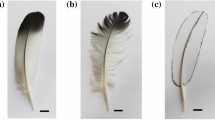Abstract
Badminton synthetic shuttlecocks are known to have significantly different aerodynamic behaviours compared to feathered shuttlecocks due to the difference in designs and use of materials. Given the fragility of avian feathers used for feathered shuttlecocks and the constantly increasing cost of purchase, the interest to assess the current synthetic shuttlecock design as a feasible alternative has re-emerged. The single-piece injection-moulded synthetic shuttlecock has been the mainstream design for the past 50 years; however, little evidence has supported that the design mimics the aerodynamics of feathered shuttlecocks. Recently, a two-part skirt design has emerged proclaiming to have surpassed its synthetic predecessor in regard to matching the aerodynamics of feathered shuttlecocks. In the current study, two different synthetic designs (injection-moulded vs two-part skirt) were benchmarked against a feathered shuttlecock. A wind tunnel test was conducted between 30 and 145 km/h. The drag coefficients of both synthetic shuttlecocks were similar to the feathered shuttlecock up to 105 km/h. Thereafter, the drag coefficient of the injection-moulded design dropped from 0.62 to 0.5 and showing no signs of levelling at speeds over 105 km/h, while the coefficient for two-part skirt design stabilised at approximately 0.55. It was concluded that the two-part skirt design better mimicked the aerodynamics of the feathered shuttlecock.







Similar content being viewed by others
Notes
13,000 < Re < 190,000 equals to velocities between approximately 3 and 44 m/s.
Data collected under the 30 km/h condition would have their values subtracted by the 30 km/h baseline value.
30–145 km/h at 15 km/h increments of wind speed equates approximately to 3.3 × 104 < Re < 1.6 × 105 at 1.5 × 104 increments Reynolds number.
References
Lin CSH, Chua CK, Yeo JH (2013) Turnover stability of shuttlecocks-transient angular response and impact deformation of feather and synthetic shuttlecocks. Proced Eng 60:106–111
Morgan JE (1996) The design and development of a shuttlecock hitting machine for training badminton players at all levels of the game. In: The engineering of sport. CRC Press, A.A. Balkema, Rotterdam, pp 103–111
Sukumar D (2016) Lee, intanon clock fastest hits. BWF World Superseries. Retrieved 19 May 2016. http://bwfworldsuperseries.com/2016/05/10/lee-intanon-clock-fastest-hits/
Crespin G (1938) U.S. Patent No. 2116304 A. Washington, DC: U.S. Patent and Trademark Office. (3 May 1938). http://www.google.com.au/patents/US2116304A. Accessed 20 Apr 2016
Carlton WC (1967) U.S. Patent No. 3313543. Washington, DC: U.S. Patent and Trademark Office. 11 Apr 1967. http://www.google.com.au/patents/US3313543. Accessed 20 Apr 2016
Goff JE (2013) A review of recent research into aerodynamics of sport projectiles. Sports Eng 16:137–154. doi:10.1007/s12283-013-0117-z
Cooke AJ (1992) The aerodynamics and mechanics of shuttlecocks. PhD Thesis. Cambridge University, Cambridge
Cooke AJ (1999) Shuttlecock aerodynamics. Sports Eng 2(2):85–96
Illusionistpro (2007) Mavis 2000 Review. http://www.badmintoncentral.com/forums/index.php?threads/mavis-2000-review.66758/. Accessed 10 May 2016
Chan CM, Rossmann JS (2012) Badminton shuttlecock aerodynamics: synthesizing experiment and theory. Sports Eng 15:61–71. doi:10.1007/s12283-012-0086-7
Badminton World Federation (2014) Laws of badminton: part II—section 1A. Retrieved 2016, from: http://www.bwfbadminton.org/file.aspx?id=473031&dl=1
Subramaniyan R (2008) Effect of local conditions on the flight trajectory of an indoor badminton shuttlecock. Dissertation draft
Hasegawa H, Kitta S, Murakami M, Obayashi S (2013) Flow analysis and aerodynamic characteristics of a badminton shuttlecock with spin at high Reynolds numbers. Sports Eng 16:91–98. doi:10.1007/s12283-013-0112-4
Cao X, Qiu J, Zhang X, Shi J (2014) Rotation properties of feather shuttlecocks in motion. Proced Eng 72:732–737
Kitta S, Hasegawa H, Murakami M, Obayashi S (2011) Aerodynamic properties of a shuttlecock with spin at high Reynolds number. Proced Eng 13:271–277
Alam F, Nutakom C, Chowdhury H (2015) Effect of porosity of badminton shuttlecock on aerodynamic drag. Proced Eng 112:430–435
Acknowledgements
The authors would like to thank the RMIT technical officers for their assistance in providing many helpful advices and feedback during the data collection phase of this study.
Author information
Authors and Affiliations
Corresponding author
Ethics declarations
Conflict of interest
The authors declare that the present study is a self-funded and individually directed project with no sponsorship and thus is not subjected to any external influence or exertion from any third-party personnel. Therefore, there are no conflicts of interest relevant to the content of this study.
Rights and permissions
About this article
Cite this article
Woo, TM.T., Alam, F. Comparative aerodynamics of synthetic badminton shuttlecocks. Sports Eng 21, 21–29 (2018). https://doi.org/10.1007/s12283-017-0241-2
Published:
Issue Date:
DOI: https://doi.org/10.1007/s12283-017-0241-2




